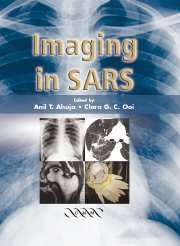Book contents
- Frontmatter
- Contents
- Contributors
- Preface
- 1 The Epidemiology of Severe Acute Respiratory Syndrome: A Global Perspective
- 2 The Role of Emergency Medicine in Screening SARS Patients
- 3 Severe Acute Respiratory Syndrome Outbreak in a University Hospital in Hong Kong
- 4 Imaging of Pneumonias
- 5 The Role of Chest Radiographs in the Diagnosis of SARS
- 6 Chest Radiography: Clinical Correlation and Its Role in the Management of Severe Acute Respiratory Syndrome
- 7 The Role of High-Resolution Computed Tomography in Diagnosis of SARS
- 8 The Role of Imaging in the Follow-up of SARS
- 9 Treatment of Severe Acute Respiratory Syndrome
- 10 SARS in the Intensive Care Unit
- 11 Imaging of Pneumonia in Children
- 12 Imaging and Clinical Management of Paediatric SARS
- 13 Imaging of SARS in North America
- 14 Radiographers' Perspective in the Outbreak of SARS
- 15 Implementation of Measures to Prevent the Spread of SARS in a Radiology Department
- 16 Aftermath of SARS
- 17 Update on Severe Acute Respiratory Syndrome
- Index
6 - Chest Radiography: Clinical Correlation and Its Role in the Management of Severe Acute Respiratory Syndrome
Published online by Cambridge University Press: 27 October 2009
- Frontmatter
- Contents
- Contributors
- Preface
- 1 The Epidemiology of Severe Acute Respiratory Syndrome: A Global Perspective
- 2 The Role of Emergency Medicine in Screening SARS Patients
- 3 Severe Acute Respiratory Syndrome Outbreak in a University Hospital in Hong Kong
- 4 Imaging of Pneumonias
- 5 The Role of Chest Radiographs in the Diagnosis of SARS
- 6 Chest Radiography: Clinical Correlation and Its Role in the Management of Severe Acute Respiratory Syndrome
- 7 The Role of High-Resolution Computed Tomography in Diagnosis of SARS
- 8 The Role of Imaging in the Follow-up of SARS
- 9 Treatment of Severe Acute Respiratory Syndrome
- 10 SARS in the Intensive Care Unit
- 11 Imaging of Pneumonia in Children
- 12 Imaging and Clinical Management of Paediatric SARS
- 13 Imaging of SARS in North America
- 14 Radiographers' Perspective in the Outbreak of SARS
- 15 Implementation of Measures to Prevent the Spread of SARS in a Radiology Department
- 16 Aftermath of SARS
- 17 Update on Severe Acute Respiratory Syndrome
- Index
Summary
Introduction
Chest radiography (CXR) not only plays an important role in the diagnosis of severe acute respiratory syndrome (SARS), it is crucial in the management of these patients. During treatment there are variable clinical and radiological responses in different patients and serial CXR help in deciding whether escalation to more aggressive treatment is necessary.
Based on our preliminary experience, we believe that changes on serial radiographs is also an important prognostic indicator.
This chapter aims to examine the correlation between the clinical course and the radiological features, and the role of CXR in the management of SARS.
Treatment protocol
The treatment of SARS patients is discussed in detail in a separate chapter (see Chapter 9). However, in order to better understand the clinical and radiological correlation one must be familiar with the basic treatment principles. These are therefore discussed briefly in the following paragraph.
Patients were treated for the first 2 days with broad-spectrum antibiotics for community-acquired pneumonia according to the American Thoracic Society Guidelines. Our initial treatment consisted of intravenous (IV) cefotaxime 1 g every 6 hours and oral clarithromycin 500 mg twice daily (or oral levofloxacin 500 mg daily for those who could not tolerate clarithromycin).
Clinical symptoms, arterial blood oxygen saturation and CXR were assessed daily.
- Type
- Chapter
- Information
- Imaging in SARS , pp. 61 - 68Publisher: Cambridge University PressPrint publication year: 2004

